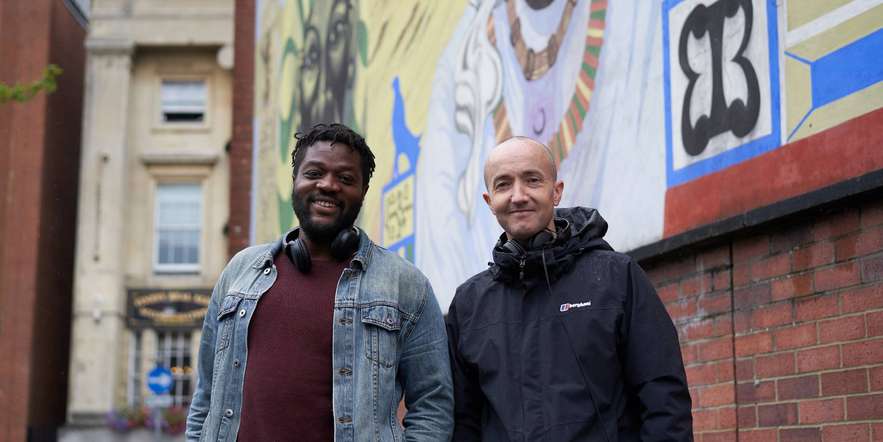
We are working with Historic England and the National Trust to launch a series of self-guided, immersive sound walks to help people discover the magic of their local high streets in September 2021.
We caught up with Richard Bentley and Aundre Goddard, the artists creating the sound walk for Reading, to find out more about the sound walk, the key themes, stories and sounds that are being explored, their relationship to the area, what they hope audiences will experience from doing the sound walk, and much more.
Can you tell us more about your Sound Walk? What are the key themes, stories and sounds that you are exploring?
Aundre: This sound walk explores the rich history of London Street in Reading. To local residents, this area is filled with fond memories of music, dancing and food. One person described it as “life with a road going through it” and capturing that celebration of life is at the heart of this sound walk. I am not a sound artist so I cannot comment on the sound elements in depth but incorporating the voices of residents is integral to this work. Their stories are what makes London Street’s history meaningful.
Richard: I’ve enjoyed supporting Aundre’s vision for the piece, as he weaves storytelling, interviews with local people and his own personal narrative through London Street’s rich history. It’s been refreshing to hear such a diverse collection of voices brought together to celebrate local historic buildings that have had the sounds of music, poetry and artisans bursting out of them over the centuries. I have been particularly interested in the way that these sounds have been sculpted by the size, materials and contents of a space, just as switching on a light illuminates the contours and furnishings of a room.
It is easy to overlook just how much of our experience of historic spaces is influenced, not only by the sounds and music found there, but the acoustics of the buildings themselves. This could be the long and lively reverberation of a dance hall, the deadened acoustic of a small, softly furnished living room or the bright, ‘pingy’ reflections from a narrow stone walkway. These acoustic properties anchor us in the specifics of a place, often without us even realising. So, for this sound walk, I wanted to support Aundre’s story-telling by bringing acoustics to the fore, literally switching between spaces and times whilst connecting with sonic memories, both imagined and real.
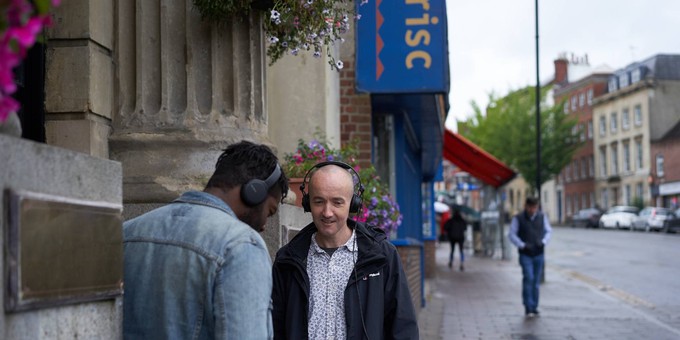
What do you hope audiences will experience from doing the Sound Walk?
Aundre: I hope audiences feel a deeper connection to Reading and its people. Often, we travel through roads without thinking about the stories behind buildings or the people that have spent time here.
Richard: I hope they can make a connection to this street either through memory or the people and activities it has hosted. In particular, I hope people enjoy experiencing the street through the buildings and materials present there. I have had the opportunity to hear the street through different ears and I hope the voices, music, field recordings and sound design deepens and re-enlivens this connection.
How long have you been working as a sound artist? How did you begin your career as a sound artist?
Aundre: This is my first gig as a sound artist so my journey starts here. I have learned a great deal from Richard Bentley during the creative process.
Richard: I’ve been a freelance sound artist now for just under ten years and before that I was a full-time music technology lecturer. I grew up playing the organ, but have always been captivated by the vast sonic possibilities of electronic music.
My earliest compositions employed synthesizers and sampling and, inspired by bands like the Future Sound of London, I recorded found sounds to tape and minidisc, sampling and layering them in my music. Then, in my teens, I would earn money by recording church wedding ceremonies. I’ve always loved the way that sound is smudged and blended in these large, reflective spaces and I’d place some of the surplus radio mics in vases, down air vents, in neighbouring rooms and all sorts of unconventional spaces, just to see how it would sound.
Later, at Bangor University in North Wales, I was exposed to the fascinating sub-culture of field recording and soundscape composition, which has formed the backbone of my sound art practice ever since.
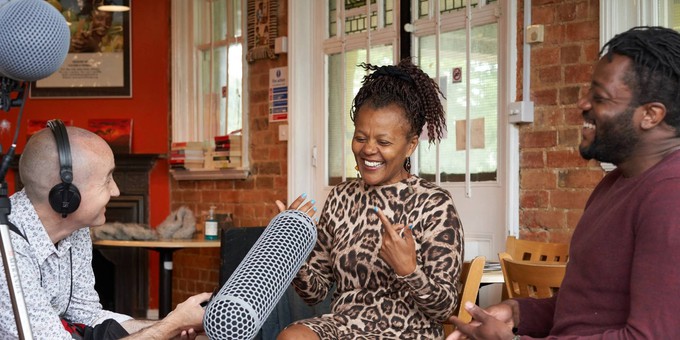
What is your relationship to Reading and how has this influenced your approach to this project?
Aundre: My relationship to Reading is deep. My parents moved here from Barbados and I was born at the Royal Berkshire Hospital so I have lived here all my life. Growing up, I spent much time around London Street. I remember this little bookshop my mum would stop at on our way home. My uncle would take me to Central Club for food and my dad used to be a bouncer at the Afterdark Club. As an adult I would go to the Great Expectations pub and attend various nights at Global Café. There is a real sense of nostalgia when I think of London Street’s mixture of cultures and that has influenced the work.
Richard: I was born and raised in Reading and have lived in and around the town all my life. I have spent many evenings at the Great Expectations pub, the Global Café, RISC, the Matrix and After Dark Clubs and vividly remember the sound of music bursting out of the buildings as you walked up the street. However, in this piece, I’ve tried to explore local places as if I’ve never heard them before. Aundre’s scripts and interviews with local people allowed me to imagine others’ listening and encouraged me to go beyond my own experiences and preconceptions.
What is the most unusual sound or interesting discovery that audiences can expect to hear during the Sound Walk?
Aundre: This sound walk is an intersection between an audio play and guided tour with interviews at its heart. I think the most interesting discovery younger audiences will encounter is how vibrant the area was. People from all over the country would travel down to London Street to attend nights at several different venues. Queues of people and cars parked in the middle of the road from top to bottom, Fatboy Slim, Supergrass, Trevor Nelson and Radiohead have all played on London Street. Looking at it now, you would never have thought it – I was shocked.
Richard: How London Street sounded in Victorian Britain, with the twist that you hear it from a drain under the street - a period enhancement!
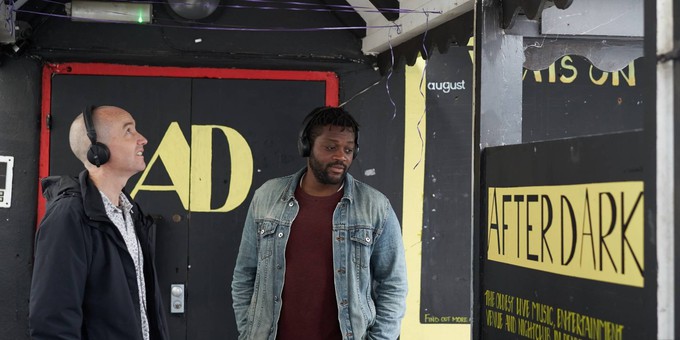
What is the most unusual sound you have recorded in your career?
Aundre: Once, I was searching for a stimulus during my devising process for a theatre piece and I placed a phone microphone in my pocket whilst I went about my day.
Richard: My practice and research largely revolves around listening more carefully to the everyday, easily forgettable sounds that surround us. In field recording, the temptation is to look for the exotic and novel, but I have been more interested in the way we listen to the mundane, rather than chasing sonic originality. Saying that, a few years ago, during an installation at the Jackson’s department store in Reading, I recorded a wonderfully exotic sound by sticking contact microphones to the back of an old fridge. You would think you were listening to a Common Frog through a vocoder (voice synthesiser)!
Personally, what do you enjoy most about Sound Walks?
Aundre: Typically, I’ve used sound in performances as a way of immersing my audience. There is an intimacy you get with sound walks, they really change my internal tempo and rhythm, which allows me to truly reflect. This past year, I have done a lot of walking for obvious reasons.
Richard: Sound walks give you the opportunity to be present to the soundscape and to appreciate the small sonic wonders peppering our lives. In this ‘audio-tour-style-sound-walk’ the listener also has an opportunity to borrow someone else’s ears for a while, as you listen to and with Aundre and myself, the actors and interviewees.
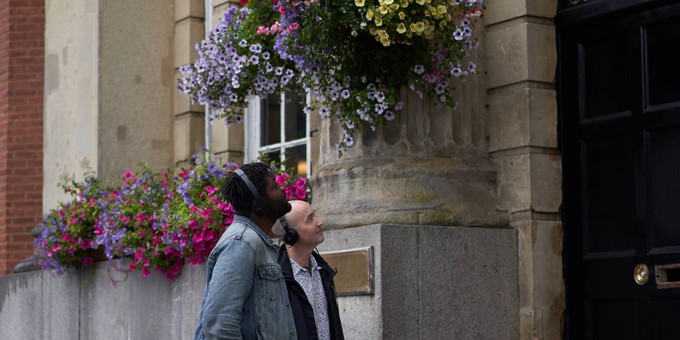
How would you describe the experience to someone who has never done something like this before?
Aundre: You know those moments in movies when the whole family would gather on the sofa to watch home-made videos? They would laugh, cry and bond about the time they time spent together all those years ago. Well, it’s a bit like that but with sound. I want the listener to feel like they were there and connect with Reading’s history and its people on a personal level. I would describe it as a comforting experience to be enjoyed.
Richard: This London Street sound walk is like opening a series of doors behind which you hear the buildings reminisce about their private lives, and the occupants relive cherished memories. It’s celebratory, so I hope it brings a smile to your lips and makes you want to dance as you walk.
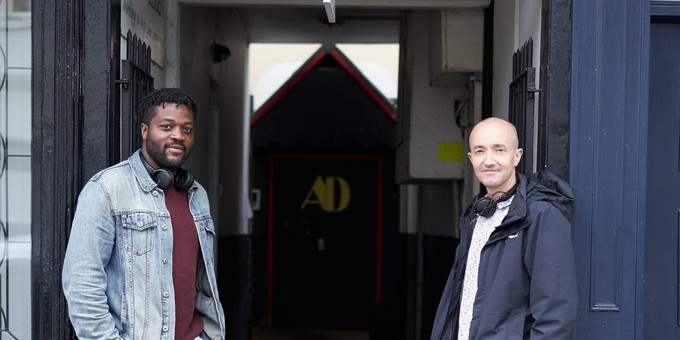
High Street Sound Walks are being launched as part of Heritage Open days and will be available from 10 September 2021. For more details on each of the Sound Walks, visit: www.HistoricEngland.org.uk/SoundWalks
High Street Sound Walks is a commission by Historic England, National Trust and Heritage Open Days with support from the players of People’s Postcode Lottery and produced by Sound UK. It is part of the High Streets Heritage Action Zones Cultural Programme, led by Historic England.
The High Street Sound Walk for Reading is produced in association with CultureMix, Readipop and Reading Borough Council.
